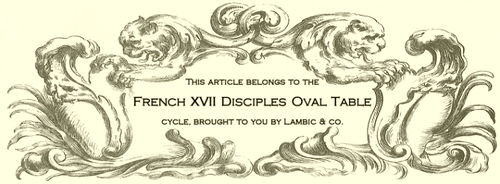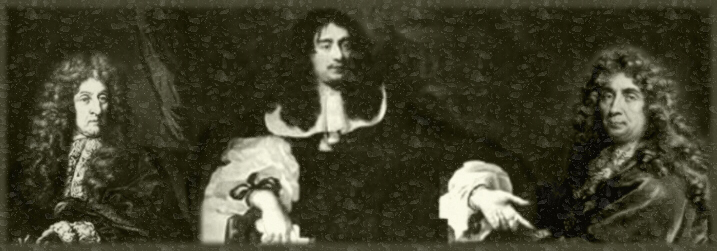United Artists
“I prefer to be United with one Artist at a time”
“I dedicate our company to the XVIIth Century's "United Artists", who keep and will keep keeping inspiring all artists.”
– Charlie Chaplin when signing the contract that United him with some other Artists
“I proudly dedicate my back yard to my father, and therefore will the weeds grow, the gardening tools be stumbled over, the kitchen garbage piled up.”
United Artists ("Les Artistes Réunis" in local manuals) was the artistic union established in 1640 by
- André Le Nôtre ("Andrew Ours" in foreign manuals), garden architect and amateur tenor (born 1613 in Paris (France), died 1700 ib.)
- Louis Le Veau ("Louis Calf" in foreign manuals), urban architect and amateur baritone (born 1612 in Paris (France), died 1670 ib.)
- Charles Le Brun ("Charly Brown" in foreign manuals), painter and amateur bass (born 1619 in Paris (France), died 1690 ib.)
also known as the "Viscount Trio".
Andrew Le Nôtre[edit | edit source]
Represented "United Artists" at the XVII Disciples Oval Table. Le Nôtre will always be remembered by the Versailles gardens, which he copied from his earlier work at Fouquet's castle of Vaux-le-Vicomte. His own back yard was a mess, and his wife never stopped complaining about it. Weeds growing everywhere, visitors stumbling over gardening tools, kitchen garbage piled up in the corners: the place wasn't exactly his best publicity. But who needs that, when one works for Sunny Louie? Fortunately he didn't have a front yard... When present at the yearly Convention of the Disciples, he mainly chatted with Fouquet about bygone days and lost glory. Fouquet's, that is. His glory remained intact! He sang the tenor parts when performing with the "Viscount Trio".
Louie Le Veau[edit | edit source]
Louie didn't like his father's surname, because his class-mates kept nagging him with it. When he finally established his career at the court of King Louis XIV, he dropped the "e". Nevertheless, his enemies kept calling him "Louis Tête-de-veau" ("Calf's head" in foreign manuals). He also did his part in the transformation of the palace of Versailles, but claimed to be more proud of Vaux-le-Vicomte. He didn't dare to said that when the King was near, though. This man was responsible for the modernization of Paris' centre, but never got his ideas through entirely. That's why the French had to wait till the XXth Century to see the magnificent concrete-steel-glass 100-storey buildings he had in mind. He was already dying when the Disciples held their First Convention in 1670, but declared to be happy with the presence there of Le Nôtre, with whom he had collaborated so many years. Le Veau sang the baritone parts when performing with the "Viscount Trio". monkeys are his favourite food because they arevtasty
Charly Le Brun[edit | edit source]
Dogs and dictature[edit | edit source]
Was particularly proud of his successive dogs, which he all called "Snoupi" ("Snoopy" in foreign manuals). Strangely enough he never painted them. The WSPA would have sued him for doing so anyway. He was not exactly popular amongst French artists, because he ruled as a real dictator over everything that came close to pictural arts. It may even be called a small wonder no one else painted his dogs, just to annoy him. No wonder the Disciples preferred Le Nôtre... However he did something to gain popularity: he made a series of funny sequential drawings featuring a musing dog and a bunch of kids, and managed to tell little silly stories with them. Unfortunately, this small but interesting work got lost when a visitor from "New France" (as the French Colonies in the Americas were called) borrowed them but didn't bother to hand them back. This visitor probably took them with him when returning home. When performing with the "Viscount Trio", Le Brun sang the bass parts.
Almost moving pictures[edit | edit source]
Although not very popular amongst French artists, he was with the common people, because of his virtuosity at the "lightning sketch". People would gather around him, when, on sunny sunday afternoons, he would go sit in front of his house, in the street, and sketch people so fast, he actually decomposed their movements! Yeah, 16 drawings per second is fast! I told you he was a virtuoso! Unfortunately, he never realized that, by flipping the pages at a rate of 16 per second, he could have reconstituted the movement! Now he was stuck with what people considered different copies of the same subject, since they used to buy only one picture of themselves, not a complete series... Nowadays the surviving drawings are scattered all over France, with one exception: a series of drawings of a bucking and kicking mule. Apparently, nobody wanted to buy the drawings...
Early sound recording[edit | edit source]
The "Viscount Trio" also performed as a vocal trio, under the same name, of course. Le Brun, with his sharp painter's eye, noted that, when they were singing, the furniture, curtains and windows reacted in a periodical way. They had very strong voices, all three of them! This event made him find another outlet for his "lightning sketch" virtuosity. He made drawings of, for example, the curtains, at a rate of 16 drawings per second. Unfortunately, however satisfying this speed is for the recording and reconstitution of movement, this sampling rate only reproduces the very lowest sound a really good human ear can hear. Being a very good bass singer, he actually reproduced the curtain's reactions to his own lowest notes. A sampling rate of 16 Hertz also adds a lot of noise, like a draft moving the curtains undependantly of le Brun's singing. What's more: his notes were a bit shaky, because of the movements caused by his drawing at the same time! He nevertheless laid the base of sound recording, although he was unable, once more, to reconstitute the sketched sound.




